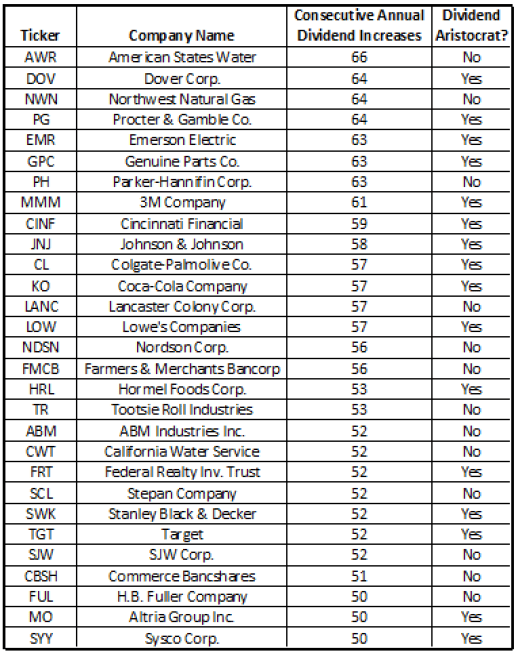
One of the goals on our blog is educate and improve the financial literacy of as many readers as possible. With that goal in mind, we create our Investing 101 series! Today’s topic will focus on an elite class of dividend growth stocks…Dividend Kings. Let’s jump right in to our latest article explaining Who & What are Dividend Kings!
What are Dividend Kings?
After the market started to tumble in 2020 as the COVID-19 pandemic took hold, investors began looking to invest in quality dividend growth stocks. I mean, can you blame them? During this economic downturn, more and more companies began cutting or suspending their dividend. Retail and oil giants slashed their dividend to preserve capital. Just like that, for some investors, the benefits of years and years of hard work, investing in dividend stocks was gone. With their wounds still fresh, investors are looking for quality dividend growth stocks. Enter Dividend Kings.
Read: Dividend Cuts in 2020 have cost Lanny nearly $1,000 in Annual Dividend Income
Dividend Kings are an elite subset of dividend paying stocks. To be considered a dividend King, there is one requirement. In fact, it is a rather simple requirement.
Dividend Kings are companies that have increased their dividend for 50+ consecutive years
Each of these companies have increased their dividend annually sine 1970! Think of how much has changed in the world, and stock market, since that time. Dividend Kings have increased their dividend through economic booms and buts. Dividend Kings maintained their dividend increase streak through two banking crises (The Great Recession in the 2000s and the S&L Crisis in the 1980s). For individuals like ourselves, that are determined to grow their passive income by investing in dividend growth stocks, this list will help provide a great foundation to build our dividend stock portfolio.
Read: Top 5 foundation Dividend Growth Stocks for your Portfolio – Which include 2 Dividend Kings
Read: Our Dividend Stock Portfolios
What Are the Differences Between Dividend Kings and Dividend Aristocrats?
Our last Investing 101 article was titled Who & What Are Dividend Aristocrats? Dividend Aristocrats, like Dividend Kings, are also companies that have increased their dividend for 25+ consecutive years. If Dividend Aristocrats have increased their dividend for 25+ consecutive years and Dividend Kings have increased their dividend for 50+ consecutive years, shouldn’t all Aristocrats be considered Kings?
The answer is no. While both categories require companies to increase their dividend annually for an extended period of time, Dividend Aristocrats have a few additional requirements. See below:

The slight differences in requirements results in a list of Dividend Kings that is more inclusive than Dividend Aristocrats. There are several companies that have increased their dividend for over 50 years that are not on the S&P 500 and have small market caps. Regardless, one thing is clear with companies on both lists: management teams that care about providing consistent, and growing, dividend to shareholders.
List of Dividend Kings
Here is the listing of of Dividend Kings as of May 16, 2020. In the table below, I listed the companies, their ticker, the number of consecutive annual dividend increases, and identified whether or not the company is also a Dividend Aristocrat. See the table below:

Now that you know the Dividend Kings – What’s Next?
We will never tell you to invest in a company just because they are a Dividend King, Dividend Aristocrat, or just simply a company that increases their dividend annually. There is a reason why the two of us don’t own every stock on the list above. These company’s check one of the major boxes in our Dividend Stock Screener…Have a Strong Dividend Growth History. But there are still two other metrics that we review in our initial stock screen!
Read: Our Simple, 3-Step Dividend Stock Screener
Once a company passes the three metrics stock screener, that’s when the fun begins. We perform additional research to see if that company will earn a spot on our next watch list or even a spot on the next day’s purchase. Some of the additional research we will perform includes reviewing the company’s average dividend growth rate, reviewing their financial statements, reading their last earnings release, and comparing the company to peers.
If you want to learn more about fundamental dividend investing and how to screen for stocks, I would suggest reviewing our Investing 101 article series, other articles on our sites, or even one of the other bloggers on our Blogroll. We aren’t the only shop for publishing great content about dividend growth investing. So definitely stop by other websites to learn more.
Read – Our Investing 101 Series
Summary
Hopefully we were able to teach you about a new class of dividend growth stocks today. We are all about building a quality, reliable, dividend income stream. Dividend Kings represent the cream of the crop of this category. Through their long term history, they have demonstrated their ability to grow their dividend through various economic cycles. In today’s environment, that is something that is greatly appreciated.
How many Dividend Kings do you own? Would you invest in any of the company’s listed above today? How many dividend growth stocks do you own in your portfolio?
-Bert

Impressive for a company to have such a long consecutive dividend raise streak while enduring all the varied economic events over those years.
Turns out I own 7 Dividend King’s out of my 50 portfolio stocks.
I’m looking to build my Sysco (SYY) position, and could see myself adding some shares to my 3M (MMM) and Lowe’s Compamies (LOW) positions.
That’s the craziest part of it all ED. Think about the economic cycles these companies managed to increase their dividend through. Just insanity.
7 is a very strong number to own, but I’m not surprised at all based on the way we analyze stocks!
Bert
I bought AWR 6 years ago and forgot they had such a long streak. I always wanted more, but the price was never right. They pay 3.14% on my original purchase but only are at 1.61% if bought today.
Love this article
Thank you very much! That is some nice growth there for AWR. I would love to get into the water utility sectors.
Bert